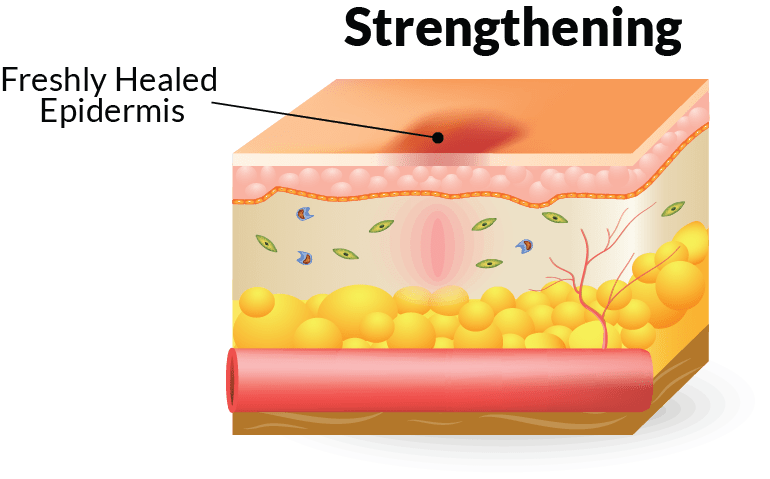Stages Of Wound Healing
This post was reviewed by our Director of Clinical Excellence and Oversight.

Hemostasis
- During the hemostasis phase, the blood begins to thicken. This is the body’s way of stopping blood flow so that too much is not lost. If the wound comes from a sudden injury, stop the bleeding from the outside with a compress as quickly as possible.

Clotting
- The blood begins to clot as soon as the skin is broken. Clotting helps the wound to scab over and begin to heal. At this stage, the wound may look red and inflamed, and it may also be warm with some clear liquid forming around it. All of these symptoms are signs that healing is taking place as white blood cells clean up the wound and help fight infection. If the wound is still actively bleeding, contact a healthcare professional.

Growth and Proliferation
- At this stage, the body sends collagen to the wound to help repair the skin. The wound will appear red, and a scar should be forming. This is normal, and the color should slowly fade. If a scar or scab does not develop during this time, contact a healthcare professional.

Strengthening
- The wound should look mostly healed, and there may be some puckering of the skin. This is a sign that the body is finishing the healing process by strengthening the tissue. The length of time the wound needs to heal depends on the wound type and severity. The healing process varies based on the type of wound. A doctor will be able to specify when each stage will occur.

Get Wound Care Supplies From Home Care Delivered
In need of wound care supplies? HCD carries a wide variety of dressings, foams, gauze, tapes, and more. Registered nurses train HCD customer representatives, so they understand wound care needs. They take care of the paperwork and follow up each month to make sure supplies are still needed. To sign up, enter a phone number in the bottom left of the screen. Signing up only takes a few minutes. Contact HCD today to get the first order shipped as soon as possible.
- https://www.healthline.com/health/skin/stages-of-wound-healing#stages-of-wound-healing
- https://www.flushinghospital.org/newsletter/the-stages-of-wound-healing/
- https://www.woundsource.com/blog/four-stages-wound-healing
- https://professionals.wrha.mb.ca/old/professionals/woundcare/documents/PrinciplesWoundHealing_WCCSpring2011.pdf
Disclaimer:
Unless otherwise noted, the recommendations in this document were obtained from the sources indicated. Be advised that information contained herein is intended to serve as a useful reference for informational purposes only. HCD cannot be held responsible for the continued accuracy of or for any errors or omissions in the information. All trademarks and registered trademarks are the property of their respective owners.
Get Insurance-Covered Wound Supplies
Accurate Orders | We Handle the Paperwork

